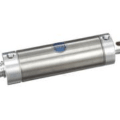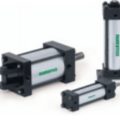Hey! This site is reader-supported and we earn commissions if you purchase products from retailers after clicking on a link from our site.
Air actuators or air cylinders are devices that create mechanical motion by converting various forms of energy (in the case of this website – compressed air) into rotating or linear mechanical motion
The air actuator converts the energy stored in compressed air into mechanical energy. The compressed air is then able to create motion or to do work, by attaching devices to the actuator rod or shaft.
An image of a typical air actuator follows, this one manufactured by Norgren.
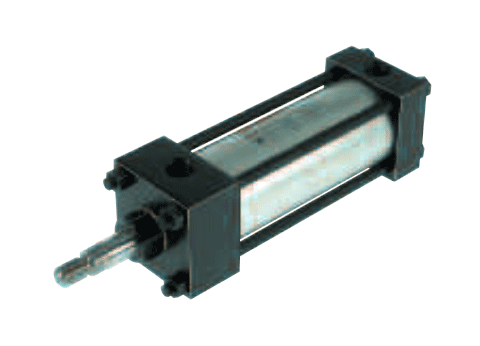
Table of Contents
Types of Actuators
The type of actuator you will need for your application will depend on what you are trying to do and the desired range of motion.
There are a wide variety of linear and rotary actuators commercially available. Options for them include electric or hydraulic actuators or the actuators we are primarily concerned with on this site, compressed air actuators.
Having a bit more information about types of actuators will help in determining which will be best suited to your application.
Electrical actuators
Electrical actuators have their place though pneumatic actuators will provide more power in a smaller package at a lower cost than electrical actuators can.
If yours is a high cycle, high speed application, electric actuators wouldn’t be your first choice. They don’t normally provide the speed that an actuator driven by compressed air can.
For precise positioning of tooling, the first choice is often the electric actuator. They can provide positioning to tighter tolerances than most air cylinders can. Also, where compressed air is not readily available, an electric actuator can be the option of choice.
Hydraulic actuators
Hydraulic actuators are the champion when it comes to brute force, easily outperforming air cylinders of the same bore size.
With hydraulics, you can generate much more force from a much smaller actuator than is possible with air.
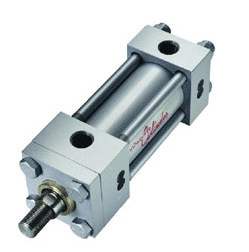
This power-to-size superiority comes at a higher cost over comparably sized pneumatic components. If it’s high brute force required with thousands of pounds of force being needed, or you need to generate relatively high force in a very small footprint hydraulic actuators are called for. Or, perhaps where there isn’t room for a pneumatic actuator of the size necessary to provide the force the application requires and you need to generate force in a smaller package. That’s where hydraulic actuators, albeit with their higher cost, shine!
Generally speaking, if you can generate the force you need with compressed air, and the actuator footprint isn’t an issue, and your application doesn’t require precise positioning of the actuator rod solely by compressed air, then air cylinder actuators would be your first choice. They are easy to obtain, have simple operation and are relatively low cost.
Then we’ll move on with more about the sizing of air cylinders and actuators for applications.
Rotary Actuators
Rotary actuators are a pretty neat devices and used creatively, can solve many applications for gripping. A picture of an SMC rotary actuator follows.
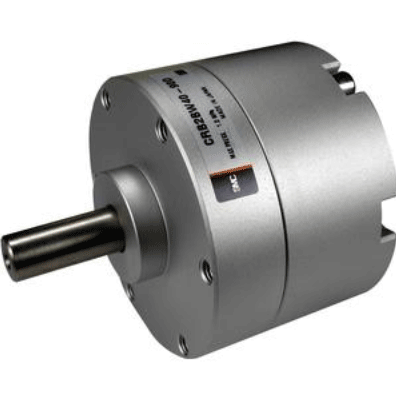
Air Actuator Sizing
When sizing the air actuator for your application, you will want to understand this concept:
Force = Pressure x Area
Cylinder piston size is important, and understanding how the formula F=PxA applies to air cylinders in general and the surface area of the cylinder piston, in particular, will help you size a cylinder.
Once you know the surface area of the cylinder or actuator piston, by knowing the air pressure that flows into the cylinder, it is fairly easy to calculate the theoretical force to be generated by that cylinder.
That force is available in theory only. Available rod-end force will be less as 10% or so of the force that is available from a specific bore size cylinder is used up to overcome the friction created by the piston and rod seals inside the cylinder.
While it has some cost ramifications, you might consider over sizing the air cylinder you select by at least 25% this to account for force loss to friction and to allow sufficient force-safety-margin when the cylinder is working.
Air Cylinder Components
Standard air cylinders/actuators have traits that are common, regardless of the manufacturer or the specifications to which that cylinder was built.
The following diagram shows the parts of a tie-rod type air cylinder. These components will be common to all of this type. The actual dimensions for a specific cylinder will vary depending on the manufacturer’s design, or the standard to which that cylinder is built ie: NFPA cylinder or ISO cylinder.

Types of air cylinder/actuators
The following are a list of links to pages on this website that provide more information about various types of air actuators.
- Air Muscle; what the heck is that? Not a lot of folks know about this technology, yet it’s been around for years now. It is an unusual type of air actuator. There is more about this type of actuator. See the link below.
- Diaphragm or Rolling Lobe air cylinders; There are a variety of air actuators available that are designed and built for a more specific reason than just the application of force. One of these is the diaphragm or rolling lobe type air cylinder. There is more about this type of actuator. See the link below.
- Double-acting air cylinders! These are the work horses of the compressed air circuit, so named, because compressed air is used to both extend and retract the rod – a double action. There is more about this type of actuator. See the link below.
- Grippers are aptly named and can be installed at the end of a cylinder or rotary actuator for any pick and place application. There is more about this type of actuator. See the link below.
- Non-repairable-air-cylinders: There is a family of lower cost air cylinders that is usually manufactured with aluminum end caps and with a stainless steel tube for a barrel. The end caps are most frequently manufactured by casting, with minimal machining involved, to help keep the cost low. Some non-repairable-air-cylinders have machined plastic or composite end caps. There is more about this type of actuator. See the link below.
- Repairable Air Cylinders are appropriately named simply due to the fact that they can be repaired when a component has failed. The most common type of repairable air cylinders are known as. There is more about this type of actuator. See the link below.
- Rodless, cable, band, magnetically coupled air cylinders are selected where a footprint issue prevents the use of a traditional and lower cost rodded type air cylinder. There is more about this type of actuator. See the link below.
- Rotary-actuators; though there are rotary actuators powered by other than compressed air, we are talking specifically about pneumatic variety. The purpose of all rotary actuators is to provide the user the ability to move the tooling in a rotary motion, instead of the linear motion provided by the typical linear air cylinder … There is more about this type of actuator. See the link below.
- Single Acting Air Cylinders can help reduce air use. Contrary to what may have been believed for years, compressed air is really quite expensive. If you have an air cylinder that’s cycling in one direction under no load, or under low load, you can reduce your compressed air consumption and money by using a single acting air cylinder… There is more about this type of actuator. See the link below.
Information about different types and styles of air cylinders and issues with them:
Magnetically coupled air cylinders
Rotary actuators (rotary cylinders)
Rolling lobe – Diaphragm air cylinders




